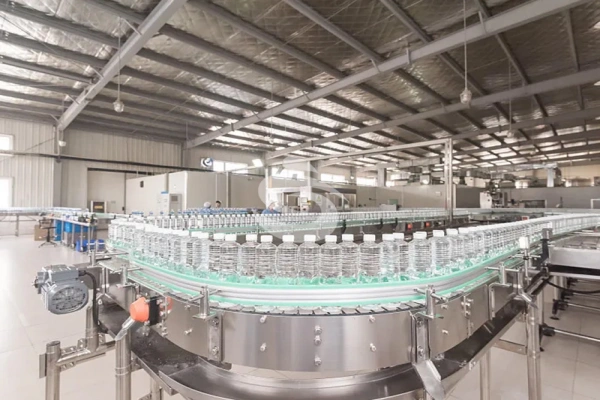Factors Affecting Filling Accuracy in Vial Filling Systems
In pharmaceutical production, accuracy in vial filling is absolutely critical! This article takes the plunger pump vial filling systems as an example to explore what really affects filling precision. In this setup, a servo motor drives the plunger rod, pushing liquid through tubing to the fixed filling needles, which then release liquid into vials.
Generally, the plunger pump maintains stable accuracy. However, things like air bubbles, fluctuating liquid levels, hose fatigue, or excessive machine speed can gradually cause inconsistent filling volumes. Let’s break it down step by step.
1. Systematic Errors
1.1 Filling System Settings
The filling system controls the entire process. Before production, operators set target volume, warning values, and correction factors. Key parameters like pump speed, suck-back, and needle height relative to the vial bottom all matter.
During filling, the pump goes through acceleration → constant speed → deceleration. If the needle is too far from the vial bottom during acceleration, liquid may splash or stick to the needle. On the other hand, if the needle doesn’t rise properly, liquid can drown the needle tip, leading to poor accuracy. Also, filling too fast builds excess pressure in hoses, causing dripping.
1.2 In-Line Weighing System
In-line weighing (IPC) is a must-have for real-time correction. It measures each vial, compares it with set values, and feeds corrections back to the control system. Hardware like high-precision scales, wireless modules, and servers all need regular calibration.
If correction parameters are well-adjusted, the piston displacement stays stable within limits, ensuring each batch is filled precisely. Without this, errors will quickly pile up.
1.3 Pump Wear
Wear and tear is inevitable. For example, if sterilization tools are made of metal, the plunger rod may scratch during cleaning, reducing air-tightness. Also, assembling mismatched pump rods and cylinders after cleaning can create gaps. Over time, this results in bubbles, leaks, and inaccurate filling.
1.4 Needle Size and Shape
Needle design is another critical factor. If the inner diameter is too small, resistance rises and flow slows down. If it’s too large, liquid may drip naturally. Flat needles are simple and allow good suck-back, but they hit the liquid hard, causing splashes. Tri-prong needles reduce splashing but are harder to manufacture and may drip if unevenly cut.
2. Random Errors
2.1 Hose Length and Deformation
A complete filling system includes hoses, pumps, and needles. If hoses are too long, they swing during operation, shaking the needle and causing drips. With repeated use, hoses expand and thin, increasing flow rate and pushing filling volumes higher than intended.
2.2 Liquid Level and Pressure Changes
Flow rate is strongly tied to inlet pressure. According to Poiseuille’s law:
Q=ΔPπd4 /(128μL)
Where: Q is volume flow rate, m3/s; ΔP is pressure difference, Pa; d is inner diameter of the pipe, m; L is length of the pipe, m; μ is dynamic viscosity coefficient, Pa·s.
As the liquid level in the tank drops, inlet pressure decreases, which reduces flow and causes underfilling.
2.3 Liquid Properties
Viscosity is a game-changer!
(1)According to the formula fluid viscosity v=μ·ρ;(2) Where: μ is the dynamic viscosity coefficient, Pa·s; ρ is the density of the liquid, kg/m3.
Combining formulas ① and ② yields Q = ΔPπd4ρ/(128μL). This means that from the start to the end of production, the liquid density, pipeline diameter, and pipeline length remain unchanged.
The liquid’s viscosity affects the dynamic viscosity coefficient, which in turn affects the flow rate in the pipeline system. This leads to changes in flow velocity, resulting in differences in filling volume and, consequently, filling accuracy. Furthermore, liquid viscosity also affects its fluidity.
2.4 Interference Factors
Small issues often snowball. Loose tubing connections, trapped air, or improper assembly may create bubbles, causing irregular volumes. Machine faults—like broken vials near weighing stations—scatter debris that interferes with measurements, leading to inaccurate feedback.
2.5 Pressure Fluctuations in Isolators
Laminar airflow isolators are key to sterile filling. Ideally, airspeed should be stable between 0.36–0.54 m/s. If airflow fluctuates too much, weighing results are distorted. This throws off correction curves, leading to filling errors.
2.6 Static Electricity
Static is sneaky! Freshly sterilized dry glass vials can easily pick up charges. Airflow or friction increases static, pulling or pushing the vial against the weighing system. This makes the displayed weight higher or lower than reality, confusing the correction process.
2.7 Vibration Effects
No surprise—vibration disrupts precision. Heavy equipment nearby, such as capping machines, shakes the filling line. Even small oscillations from servo motors can throw off weighing accuracy. Minimizing vibration sources is crucial.
2.8 Suck-Back Settings
Suck-back helps prevent drips by reversing pump motion slightly. But balance is everything—too much creates bubbles, too little fails to stop leakage. During downtime, liquid may dry around the needle tip, further affecting filling accuracy. A well-tuned suck-back is essential!
3. Conclusion
Today, modern vial filling systems already have good control measures: optimized hose lengths, airflow stability, and static elimination. But challenges remain—like pump wear, vibration, and human error.
The future of liquid filling is clear: higher precision, stronger stability, and better reliability. With continuous improvements in design, manufacturing, and operation, we can keep pushing filling accuracy to new levels.


